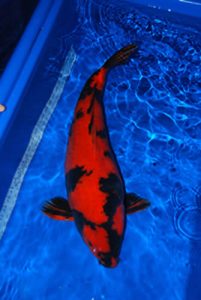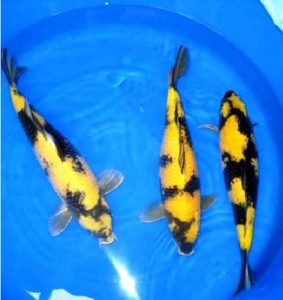Utsuri – Shadow and Light by Bryan Bateman
Shiro Utsuri (pronounced SHE-row oot-SOO-ree) is a member of the Utsuri class at koi shows, which also includes Ki Utsuri (yellow and black), and Hi Utsuri (red and black). Of these three, the Shiro Utsuri, or white and black koi, is by far the most popular, and will often compete with Gosanke – Kohaku, Sanke, and Showa – for Grand Champion at koi shows.
“Utsuri” translates from the Japanese as “reflection”, which refers to a tendency these koi have of displaying alternating markings, much like a checkerboard, on their bodies. Modern patterns vary, however, from the traditional checkerboard type to a limitless array of artistic interpretations. We see banded “bumble-bee” patterns, or we may see continuous “inazuma” or lightning type patterns that run to and fro over the entire koi from head to tail, or maybe a koi with just a few brush-mark splashes of sumi seeming to float on a sea of white.
A similar variety often confused with Shiro Utsuri is Shiro Bekko, which is also a black and white koi. The difference between these two types lies in the location and shape of the black markings. While Utsuri normally exhibit larger, wrapping black markings, which will often appear on the head as well as on the body, Bekko are distinguished by the small stepping-stone type of markings appearing on the body but not on the head, much like we see on Sanke.
The ratio of black to white on a Shiro Utsuri is largely a matter of personal preference, but in koi shows, a Shiro exhibiting a greater proportion of white to black will generally fare better.
Other appreciation points are that the pectoral fins should have moto guro, or black patches, at the base of each fin, and that the other fins should be all or mostly white.
The black pattern should have an artistic balance that is pleasing to the eye, with not too much front vs back or side vs. side, and there should be some black on the head region – preferably forming an eye-catching complement to the overall pattern. This contrast of black and white, with no other colors, creates a beautiful and intriguing fish which will complement any koi pond.
© Bryan Bateman 2009





